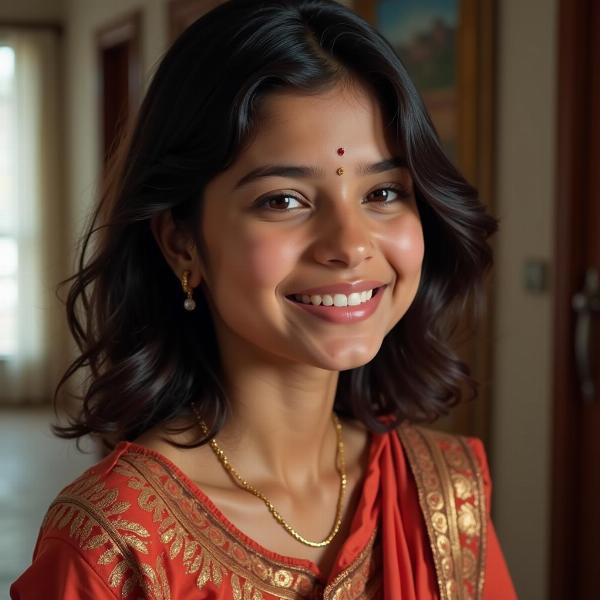Blushed meaning in Hindi encompasses a range of emotions, from a gentle flush of shyness to the deeper crimson of embarrassment. Understanding these nuances is key to navigating social situations and appreciating the richness of Hindi expressions. This article will delve into the various ways “blushed” is translated in Hindi, exploring the cultural context and providing practical examples to help you grasp the subtleties of this common human experience.
The Many Faces of “Blushed” in Hindi
Hindi offers a diverse vocabulary to describe the act of blushing, reflecting the cultural significance of nonverbal communication. While English relies primarily on “blushed,” Hindi uses various words and phrases to capture the specific shade of meaning. Let’s explore some of the most common translations:
- शरमाना (sharmana): This is the most common and versatile Hindi word for blushing. It encompasses a wide spectrum of emotions, from bashfulness to shyness to embarrassment. It can be used in various contexts, making it a fundamental term to understand.
- लज्जाना (lajjana): Similar to sharmana, lajjana implies shyness and modesty, often associated with a gentle blush. It carries a slightly more feminine connotation, often used to describe the blushing of a young woman.
- मुँह लाल होना (munh lal hona): Literally meaning “face becoming red,” this phrase vividly describes the physical manifestation of blushing. It’s a more descriptive and less nuanced term than sharmana or lajjana.
- गाल लाल होना (gaal lal hona): This translates to “cheeks becoming red,” focusing specifically on the cheeks as the locus of the blush. This phrase highlights the visible change in complexion.
- झेंप जाना (jhemp jana): This phrase suggests a feeling of being overwhelmed with shyness or embarrassment, often leading to blushing. It implies a stronger reaction than simply sharmana.
 Indian woman blushing
Indian woman blushing
Cultural Context: Blushing and Indian Etiquette
In Indian culture, blushing is often associated with modesty, humility, and respect, particularly for women. It’s seen as a positive trait, a sign of good upbringing and a respect for social norms. However, excessive blushing can also be perceived as a sign of nervousness or insecurity. Understanding these cultural nuances is crucial for effective communication.
Common Scenarios and Expressions
Imagine a young woman receiving a compliment on her cooking. She might respond with a shy smile and a slight blush, saying, “आपकी बड़ाई है (aapki badaai hai)” – “It’s your kindness.” This demonstrates humility and appreciation while acknowledging the compliment.
What if a student is caught making a mistake in class? They might sharmana and apologize, demonstrating their understanding of the error and their respect for the teacher.
Blushing Beyond Shyness: Exploring Related Emotions
While shyness is often the primary association, blushing can also be a sign of other emotions like embarrassment, guilt, or even anger. Understanding the context and accompanying body language is key to interpreting the true meaning of the blush. For instance, someone caught in a lie might blush intensely, their munh lal hona a clear indicator of their discomfort.
How to Say “I Blushed” in Hindi
Depending on the specific nuance you want to convey, you can use several phrases:
- मैं शरमा गया/गई (main sharma gaya/gai): This is the most common way to say “I blushed,” suitable for most situations. Use “gaya” for males and “gai” for females.
- मैं लज्जा गया/गई (main lajja gaya/gai): This conveys a sense of shy modesty, more appropriate for situations involving compliments or praise.
- मेरा मुँह लाल हो गया (mera munh lal ho gaya): This descriptive phrase emphasizes the physical aspect of blushing.
Conclusion: Navigating the Spectrum of Blushing in Hindi
Understanding the various ways to express “blushed” in Hindi provides valuable insights into Indian culture and communication. From the gentle sharmana to the more intense jhemp jana, these words and phrases paint a vibrant picture of human emotion. By mastering these nuances, you can enhance your understanding of Hindi and navigate social interactions with greater sensitivity and cultural awareness.
FAQ:
- What is the most common Hindi word for blushed? Sharmana (शरमाना) is the most common and versatile word.
- Is blushing considered positive or negative in Indian culture? Blushing is generally seen as a positive trait, associated with modesty and respect.
- How do you say “I blushed” in Hindi for a female? मैं शरमा गई (main sharma gai) or मैं लज्जा गई (main lajja gai).
- What are some other emotions associated with blushing besides shyness? Embarrassment, guilt, and even anger can cause blushing.
- Why is understanding the context important when interpreting blushing? The context and accompanying body language help determine the true meaning of the blush.
Connect with Meaning-Hindi.in for Expert Hindi Translation Services
Meaning-Hindi.in is your trusted partner for accurate and culturally sensitive Hindi translation services. We specialize in various domains, including business, legal, technical, website localization, educational, and specialized translations. Our team of expert linguists ensures your message is conveyed effectively while respecting cultural nuances. Contact us today for all your Hindi translation needs!
Email: [email protected]
Phone: +91 11-4502-7584
Connect with Meaning-Hindi.in for seamless communication across cultures.